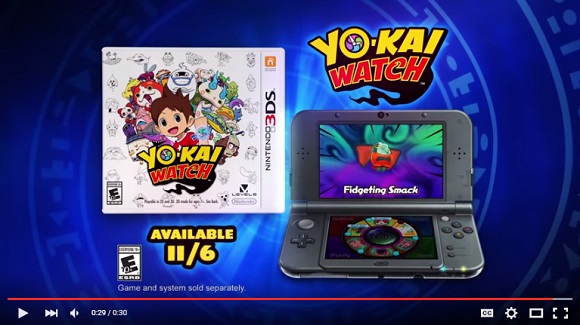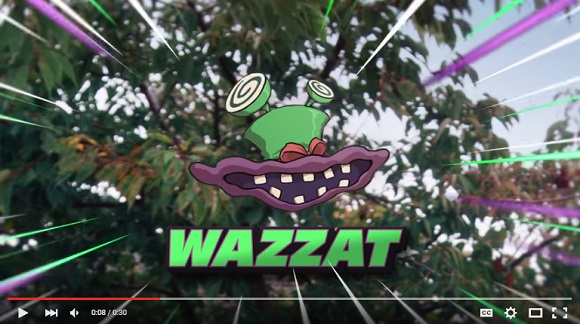
We’ve been telling our fine readers for literally years now about Yo-kai Watch, the Pokémon-esque game/manga/anime series that’s full of adorable yet mischievous collectible yokai monsters. And now that the series has been newly localised and adapted for the West, you’re finally going to see for yourselves what’s been driving Japanese kids to ritually torch bonfires of old Pokémon goods in favour of worshipping the new yokai overlords. Okay, we’re exaggerating, but only a little bit.
Of course, the success of any Japanese import into the Western market hinges on a heartfelt and thorough localisation process. It happened to Pokémon—Satoshi became Ash Ketchum, and many Pokémon were entirely renamed—and now it’s happening to Yo-kai Watch, too.
But is the very Japanese charm of the new franchise about to be seriously lost in translation?
As we previously reported, protagonist Keita Amano has become the very American-sounding Nate Adams, while yokai is remaining the de facto term of choice for the naughty but very cute critters, albeit with the vowel-lengthening “u” dropped, possibly to prevent people mispronouncing it as you (as in “you and I”) kai.
Although the series’ number-one yokai and Pikachu rival Jibanyan is retaining his Japanese name (which is actually derived from ‘resident ghost’ and ‘meow’), the other ghost characters are being renamed entirely, with many a Japanese pun getting steamrolled into something a little less clever all in the name of relatability. Wasurenbou, for example—that naughty yokai which is the reason why we humans always “forget” our keys—has become the rather uninspiring “Wazzat” for the US release of the series, which we’re kinda scratching our heads over. Wasurenbou is a clever play on “forgetful” and “hat”, due to his hat-like shape, but “Wazzat” reminds us more of those annoying Budweiser ads from about 10 years ago, and we feel like the ‘hat’ part isn’t given as much punch as in Japanese.
Similarly, Morezou, the yokai that wreaks havoc on your bladder at inopportune moments, and whose name is derived from “moreru” (to leak) and “zou“, or elephant, becomes “Fidgephant” in the English release. We’re guessing that needing to pee does make you fidget a bit, but again the pun is a lot less apparent than in Japanese. Still, it’s easy enough to criticise, but harder to come up with inventive, punny names for hundreds of characters, we suppose…
Those two new yokai are revealed in this brand new US commercial advertising the Nintendo 3DS game which is due for release in North America on November 6.
https://www.youtube.com/watch?time_continue=30&v=KfWQ-PQPy4U
Cheesy commercial aside (Yokai is why, anyone?) there’s plenty to be excited about—the game is technically excellent and one of the best things developers Level 5 (known for the Professor Layton games, Ni no Kuni and Fantasy Life) have put out. If you’re a fan of bright, colourful RPGs with addictive gameplay, you really owe it to yourself to pick this up, whether or not Pokémon appealed to you.
Whether or not the localisation remains faithful to the original isn’t really the point, though. Purists may argue that the original creators’ vision is the most important thing, but as far as non-Japanese speaking Western players are concerned, the English localisation is all that they have access to, and therefore all that counts. And the effort, care and consideration that goes into localising and translating a quintessentially Japanese game like this one can not be underestimated. We’re looking forward to playing the Westernised Yo-kai Watch, and while we as bilinguals may be in a position to critically evaluate all of the differences, for the majority of American kids, all they’re going to care about is how much fun they’re about to have collecting yokai.
Source: AOL News JP
Images: Screenshot via YouTube/Nintendo



 “Jibanyan, I choose you!” Does Yo-kai Watch have the power to topple Pokémon?
“Jibanyan, I choose you!” Does Yo-kai Watch have the power to topple Pokémon? Kids rejoice! Universal Studios Japan to get Yo-kai Watch attraction this summer
Kids rejoice! Universal Studios Japan to get Yo-kai Watch attraction this summer Yo-Kai Watch debuts abroad: characters get name changes but songs retain their epic nature【Video】
Yo-Kai Watch debuts abroad: characters get name changes but songs retain their epic nature【Video】 Why Twitter is awesome: Yo-kai Watch in different art styles
Why Twitter is awesome: Yo-kai Watch in different art styles Yo-kai watch what the western Yo-kai Watch doesn’t want you to yo-kai watch
Yo-kai watch what the western Yo-kai Watch doesn’t want you to yo-kai watch Hayao Miyazaki says Happy New Year to Studio Ghibli fans with new art for Year of the Horse
Hayao Miyazaki says Happy New Year to Studio Ghibli fans with new art for Year of the Horse Pizza Hut Japan’s hot lucky bags are perfect for a New Year’s pizza party
Pizza Hut Japan’s hot lucky bags are perfect for a New Year’s pizza party Uniqlo Ukiyo-e Blue T-shirts: A cool-hued reinterpretation of some of Japan’s greatest paintings
Uniqlo Ukiyo-e Blue T-shirts: A cool-hued reinterpretation of some of Japan’s greatest paintings Inakaya Denim jeans are the latest farm-fresh Japanese-inspired fashion item
Inakaya Denim jeans are the latest farm-fresh Japanese-inspired fashion item Visiting Hokkaido’s adorable and awesome Asahikawa rice paddy art【Photos】
Visiting Hokkaido’s adorable and awesome Asahikawa rice paddy art【Photos】 Osaka teen arrested for hacking into Internet cafe’s app to steal data, was helped by Chat-GPT
Osaka teen arrested for hacking into Internet cafe’s app to steal data, was helped by Chat-GPT Turns out you can draw all four original starter Pokémon with just three colored pencils【Video】
Turns out you can draw all four original starter Pokémon with just three colored pencils【Video】 The best Starbucks Japan Frappuccinos we want to drink again in 2026
The best Starbucks Japan Frappuccinos we want to drink again in 2026 Mr. Sato accosts award-winning actor Hideaki Ito【Interview】
Mr. Sato accosts award-winning actor Hideaki Ito【Interview】 We revisited Sweets Paradise after a decade to see if Japan’s dessert buffet still delivers
We revisited Sweets Paradise after a decade to see if Japan’s dessert buffet still delivers Starbucks Japan ready to get Year of the Horse started with adorable drinkware and plushies【Pics】
Starbucks Japan ready to get Year of the Horse started with adorable drinkware and plushies【Pics】 Cyberpunk anime meets traditional culture in Ghost in the Shell gold leaf Japanese changing screens
Cyberpunk anime meets traditional culture in Ghost in the Shell gold leaf Japanese changing screens 7 great places to see Mt. Fuji from without having to climb it
7 great places to see Mt. Fuji from without having to climb it Hello Kitty Choco Egg figures are an adorable trip through three periods of Japanese pop culture【Pics】
Hello Kitty Choco Egg figures are an adorable trip through three periods of Japanese pop culture【Pics】 7-Eleven Japan’s ramen-cooking robot whipped us up a bowl of noodles【Taste test】
7-Eleven Japan’s ramen-cooking robot whipped us up a bowl of noodles【Taste test】 We found possibly the quietest Japanese-style hotel in Tokyo’s bustling Shinjuku district
We found possibly the quietest Japanese-style hotel in Tokyo’s bustling Shinjuku district Japan’s otoshidama tradition of giving kids money at New Year’s gets a social welfare upgrade
Japan’s otoshidama tradition of giving kids money at New Year’s gets a social welfare upgrade Sumo Sanrio! Hello Kitty and pals team up with Japan Sumo Association for new merch【Pics】
Sumo Sanrio! Hello Kitty and pals team up with Japan Sumo Association for new merch【Pics】 More Than a Capsule Stay: Why Solo Travelers Choose “global cabin Yokohama Chinatown”
More Than a Capsule Stay: Why Solo Travelers Choose “global cabin Yokohama Chinatown” Japan’s oldest largetooth sawfish in captivity back on display in Mie Prefecture
Japan’s oldest largetooth sawfish in captivity back on display in Mie Prefecture 7-Eleven Japan starts new temporary luggage storage service in over 300 branches
7-Eleven Japan starts new temporary luggage storage service in over 300 branches Disillusionment at Tsukiji’s tourist-target prices led us to a great ramen restaurant in Tokyo
Disillusionment at Tsukiji’s tourist-target prices led us to a great ramen restaurant in Tokyo Starbucks teams up with 166-year-old Kyoto doll maker for Year of the Horse decorations【Photos】
Starbucks teams up with 166-year-old Kyoto doll maker for Year of the Horse decorations【Photos】 Tokyo considering law requiring more trash cans following litter increase in heavily touristed area
Tokyo considering law requiring more trash cans following litter increase in heavily touristed area Tokyo’s Tsukiji sushi neighborhood asks tour groups to stay away for the rest of the month
Tokyo’s Tsukiji sushi neighborhood asks tour groups to stay away for the rest of the month Tokyo event lets you travel back in time, for free, to celebrate 100 years since Showa era start
Tokyo event lets you travel back in time, for free, to celebrate 100 years since Showa era start Sanrio theme park in Japan announces plans to expand into a Sanrio resort
Sanrio theme park in Japan announces plans to expand into a Sanrio resort Japan may add Japanese language proficiency, lifestyle classes to permanent foreign resident requirements
Japan may add Japanese language proficiency, lifestyle classes to permanent foreign resident requirements Stamina-destroying “Paralysis Noodles” are Tokyo’s newest over-the-top ramen innovation
Stamina-destroying “Paralysis Noodles” are Tokyo’s newest over-the-top ramen innovation Survey asks foreign tourists what bothered them in Japan, more than half gave same answer
Survey asks foreign tourists what bothered them in Japan, more than half gave same answer Japan’s human washing machines will go on sale to general public, demos to be held in Tokyo
Japan’s human washing machines will go on sale to general public, demos to be held in Tokyo Japan’s deadliest food claims more victims, but why do people keep eating it for New Year’s?
Japan’s deadliest food claims more victims, but why do people keep eating it for New Year’s? We deeply regret going into this tunnel on our walk in the mountains of Japan
We deeply regret going into this tunnel on our walk in the mountains of Japan Studio Ghibli releases Kodama forest spirits from Princess Mononoke to light up your home
Studio Ghibli releases Kodama forest spirits from Princess Mononoke to light up your home Major Japanese hotel chain says reservations via overseas booking sites may not be valid
Major Japanese hotel chain says reservations via overseas booking sites may not be valid Put sesame oil in your coffee? Japanese maker says it’s the best way to start your day【Taste test】
Put sesame oil in your coffee? Japanese maker says it’s the best way to start your day【Taste test】 No more using real katana for tourism activities, Japan’s National Police Agency says
No more using real katana for tourism activities, Japan’s National Police Agency says Starbucks Japan reveals new sakura drinkware collection, inspired by evening cherry blossoms
Starbucks Japan reveals new sakura drinkware collection, inspired by evening cherry blossoms Updated cherry blossom forecast shows extra-long sakura season for Japan this year
Updated cherry blossom forecast shows extra-long sakura season for Japan this year Japan’s kids love game series Yo-Kai Watch, and one fan says it’s because grownups don’t
Japan’s kids love game series Yo-Kai Watch, and one fan says it’s because grownups don’t Yo-kai Watch starts 2018 on a gloomy note with store closings
Yo-kai Watch starts 2018 on a gloomy note with store closings Yo-kai Watch mania has even reached the vegetable world! Here’s a Halloween pumpkin roundup!
Yo-kai Watch mania has even reached the vegetable world! Here’s a Halloween pumpkin roundup! Yo-kai Watch sales fall drastically in 2016, future does not look bright for fabled spirits
Yo-kai Watch sales fall drastically in 2016, future does not look bright for fabled spirits Yo-Kai Watch 2 continues to dominate video game sales in Japan
Yo-Kai Watch 2 continues to dominate video game sales in Japan Investors watching Yo-Kai Watch as hit game/anime series leads stock rally in Japan
Investors watching Yo-Kai Watch as hit game/anime series leads stock rally in Japan McDonald’s Japan offers Yo-Kai Watch cards with Happy Meals, traffic jams and giant lines ensue
McDonald’s Japan offers Yo-Kai Watch cards with Happy Meals, traffic jams and giant lines ensue Pikachu and Super Mario left out of lineup of official spokescharacters for Tokyo Olympics
Pikachu and Super Mario left out of lineup of official spokescharacters for Tokyo Olympics Youkai Watch set to embrace modernity with new “Youkai Pad” accessory
Youkai Watch set to embrace modernity with new “Youkai Pad” accessory
Leave a Reply